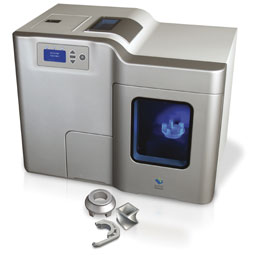![The new MakerBot Experimental Extruder is able to handle many different materials [Source: MakerBot]](https://fabbaloo.com/wp-content/uploads/2020/05/image-asset_img_5eb067e614b45.jpg)
The new MakerBot Experimental Extruder is able to handle many different materials [Source: MakerBot]
MakerBot announced a new experimental extruder for their METHOD line of 3D printers, saying it “Transforms METHOD 3D Printer into an Open Materials Platform”.
This is a fascinating announcement in several ways, not the least of which is that it in a way completes the circle: MakerBot began in 2009 as a fully open source company, with all equipment able to use any material. They went through a “closed” phase, but now are back to “open materials”.
Open vs Closed 3D Print Materials
But when you look at what “open” means, the definition is quite a bit different these days.
In the early days of desktop 3D printing you were lucky to have a device print anything. Equipment failures, software complications, material uncertainty and a complete lack of print profiles made 3D printing a risky business at best. You were essentially on your own.
Professional 3D Printing
In recent years that’s changed significantly, mostly due to the collapse of consumer 3D printing that occurred in 2015-16. At that time the 3D printer manufacturers shifted their focus from general consumers to professionals. This new market would be prototyping parts and producing low-volume batches.
For those operations, professionals required two key things: better and more predictable materials; and more reliable and consistent 3D print results.
Most 3D printer manufacturers pursued these goals, or they died. Equipment was made more robust with better basic materials (e.g., metal instead of wood or acrylic), and far better electronics and mechanical components. Software was made far more sophisticated and easy to use.
Material availability was broadened by the entry of major chemical companies, who unleashed their decades-old catalogs of many thousands of materials onto the 3D printing market. 3D printer manufacturers adjusted their machine designs to accommodate the new materials through better components and higher temperatures.
3D Print Quality Strategies
A common approach for increasing print quality in 3D printer design was to include sensors to detect “out of bounds” conditions, and allow the machine’s firmware to react appropriately. MakerBot is definitely one of the leaders in this area, as their METHOD line of 3D printers includes literally dozens of sensors of all types. This allows them to achieve one of the highest quality 3D print results in the industry.
However, to truly achieve the best print results, the 3D printer’s software must be acutely aware of the material chemistry so that it can tune the printer’s actions to match the material. This is the core fact of closed materials: in order to get the best results, you must precisely know the material.
This is true even in “open materials” machines, where the operator can no doubt achieve very fine results — but only after much tedious print parameter tuning. Tedious tuning that can take hours or days is not something professionals can afford to do. That’s why they are usually intensely interested in equipment that has pre-made print profiles that are known to work.
3D Print Material Choice
![Installing the new MakerBot Experimental Extruder [Source: MakerBot]](https://fabbaloo.com/wp-content/uploads/2020/05/image-asset_img_5eb067e635995.jpg)
Installing the new MakerBot Experimental Extruder [Source: MakerBot]
However, there’s still a problem: a manufacturer of 3D printers can supply only a limited number of materials with profiles. This means a client may be receiving great prints, but only in a limited set of materials. What if other materials are required for a particular application?
This is where MakerBot’s new Experimental Extruder comes in. It seems that MakerBot is really trying to bridge the Wild West world of open materials with the closed, high-quality world of known print profiles. It should be able to provide a more broad material choice for METHOD 3D printer operators.
While the Experimental Extruder could, in theory, be used for almost any random thermoplastic material due to its hardened nozzle and 300C maximum temperature, that’s not really the intention. The goal here is to allow more materials into the METHOD 3D printers but also ensure the print results are of the same high quality.
There’s no point in 3D printing random materials on the METHOD to “save money on materials” because the METHOD is designed to achieve ultra-high-quality prints. Random materials will not achieve that quality unless there is significant print tuning undertaken, and for the reasons stated above, is not something METHOD operators would do.
MakerBot Material Partnerships
![The new MakerBot Experimental Extruder handles several new engineering materials [Source: MakerBot]](https://fabbaloo.com/wp-content/uploads/2020/05/makerbot-material-partners_img_5eb067e672ca5.jpg)
The new MakerBot Experimental Extruder handles several new engineering materials [Source: MakerBot]
Thus MakerBot is teaming with a series of high-quality filament manufacturers to develop a larger portfolio of ready-to-use materials & profiles. So far, their list includes Polymaker, Jabil, Kimya and Mitsubishi, who are providing a variety of materials including polycarbonate, electrostatic dissipative, TPE, carbon fiber, PETG and a biocompatible material.
I expect MakerBot to add a significantly greater number of interesting materials to their portfolio in coming months. This would make the METHOD a very powerful machine able to reliably produce quality prints in many engineering materials.
MakerBot sells the Experimental Extruder as a swap-in accessory, and thus any METHOD operator could enable this broad material capability by simply popping it into their METHOD 3D printer.
Via MakerBot

